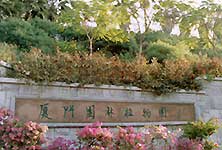Attration Category
Xiamen Weather

Xiamen Botanical Garden, known as the Wanshi Botanical Garden, is a carefully designed botanical garden around Modanyan Reservoir on the northern slope of Shi Mountain in southeast urban area of Xiamen. Modanyan reservoir was built in 1952 with extension of Wanshi Botanical Garden, which is divided into more than 20 botanical zones, cultivating grounds and display rooms for more than tens of thousands of cultivated tropical, subtropical plants including palms, bamboo, orchids, bonsai and medicinal plants. Wanshi Botanical Garden has scenic spots such as the Morning Bell of Heaven, the Reading and Music Playing Cave, the Cloud Locking Stones, the Jade Scepter Rock and the Peace Stone.
Xiamen Botanical Garden is set amidst Wanshi Mountain in the southeastern part of Xiamen Island, also known as Wanshi Botanical Garden. It's an integral part of the Gulangyu Islet - Wanshi Mountain National Key Scenic Spot, covering an area of 4.93 square kilometers. The garden is set on rolling hills and dotted with grotesque rocks, forming a dramatic rocky landscape. The granite boulders throughout the garden are graced with calligraphic inscriptions of ancient men of letters. Major tourist attractions in the garden include "Laughing Rocks of Eternal Peace", "Dawn Bell Ringing from Heaven's Border", "A Thousand Scepters Facing Skywards", "Jade Scepter on Central Boulder", "Road on Purpled Cloud", and "Melodious Instrument Cave", all of which are on the list of Xiamen's top sights. There are also various provincial- and municipal-level cultural heritage sites in the garden, including the site of execution of Zheng Lian by Zheng Chenggong (Koxinga), the site where Zheng Chenggong used to read classics, the terrace built in memory of killed soldiers from Penghu. The garden is also home to several of Southern Fujian's most renowned temples, including the Heaven's Border Temple, the Wanshi Lotus Temple, and the Eternal Peace Rock Temple.
The garden, first built in 1960, contains more than 6,300 kinds of tropical and subtropical ornamental plants and comprises 10-plus unique smaller dedicated gardens, such as the psammophytes area, the "Palm Island", the "Rainforest World", and the araucaria lawn. In 1984, Deng Xiaoping, the chief architect of China's reform and opening-up drive, personally planted a Nepal camphor on the araucaria lawn.
The garden receives more than 1 million visitors annually. It's a leading tourist spot in Southern Fujian and one of the most distinctive gardens in Southern China, featuring enchanting natural landscape, rice cultural heritage, and fantastic plant formations. It's among China's first group of AAAA scenic spots and a national-class base for popular science education.


